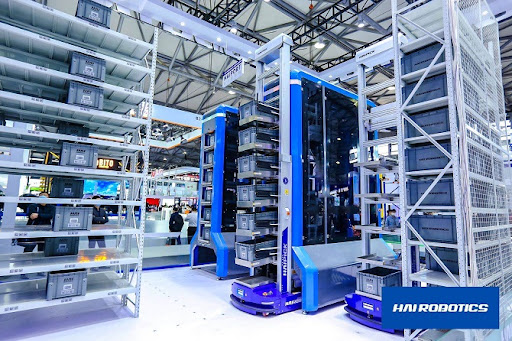
Autonomous Mobile Robots
Is This the Golden Age of AMRs?
In spite of the pandemic and because of the pandemic, AMRs have not only flourished, they have massively proliferated. Forecast for 2028: $7 billion!
“Robotics Outlook 2030: How Intelligence and Mobility Will Shape the Future”
—Boston Consulting Group
Intelligence & mobility
Unless you’ve been under a rock somewhere, you’ve undoubtedly heard the noise of their wheels and the rush of their whizzing by you, either on TV news, YouTube, or better, in person. What you’re seeing and hearing is the future arriving in a hurry. They’re called AMRs, robotics newest celebrities, autonomous mobile robots.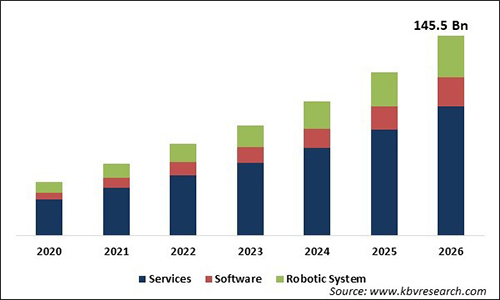
I got my first glimpse of them back in 2018, at MODEX. Way off in a corner on some subterranean level, next to the snack bar and the men’s room, was a too small booth stuffed with a bunch of Chinese guys and their AMR gear. They called themselves Geek+. One look at their AMR tech gear was all anyone needed to know that these machines were a whole new species of robot. I knew in an instant that these AMRs where about to change everything in logistics, and that logistics was ready and waiting for them.
Perfect timing. They had arrived as ecommerce was beginning to churn the hell out of everything before it. Yes, for sure there were AGVs around and massive AR/RS erector sets, but nothing quite like these non-stop, merchandise whirlwinds that, when enough were put into action, could take on any ecommerce deluge headed their way. Plus, they are adaptable and a flexible fit for almost any kind of warehouse, DC or Fulfillment Center.
Old warehouse, new warehouse, teeny, small or massive warehouse, where ever merchandise needs to be stored, moved and shipped out, these were the machines to do it, quickly and productively.
I wrote an article about them back then called Make Way for the Kiva Killers: Geek+ Has Arrived. Fleet of Chinese logistics robots debut in North America.
See related:
Make Way for the Kiva Killers: Geek+ Has Arrived
Fleet of Chinese logistics robots debut in North America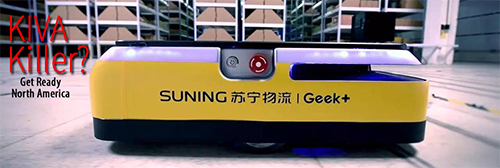
Since then, and in spite of the pandemic and because of the pandemic, AMRs have not only flourished, they have massively proliferated.
Now there’s even a new-kid-on-the-block HAI ROBOTICS with its “tall boy” AMRs that not only are smart and mobile, but they can reach up to grab or put away totes to a height of 5 meters (16 feet)…for even more room for inventory.
AMRs replace traditional fulfilment tools targeted at increasing merchandise picking efficiency and productivity. They are used for order picking operations, zone picking, goods-to-person, autonomous piece picking or flexible sortation.
The best testimony as to the logistics-taming skills of these AMRs is how adept they are at killing off a bloated bottom line. Deutsche Bank estimates that AMRs have cut picking cycle times from 60 to 75 minutes to roughly 15 minutes; that inventory space grew 50 percent per warehouse due to smarter use of space; and that AMRs in the hands of the likes of Amazon saved the ecommerce behemoth over $20 million per warehouse using AMRs.
Analysis websites like StyIeintelligence publish AMR charts crowded with the teeny logos of hundreds of AMR vendors. Old-line robotics and automation vendors are out shopping for and buying up these teeny logos as fast as possible. No one in automation wants to be left behind by the AMR movement.
Even a telco conglomerate like Verizon jumped in and acquired Austrian-based incubed IT, making for a nice edition to its 5G and edge compute tech. And even robot logistics vendors like Locus Robotics saw wisdom in acquiring AMR maker Waypoint. Then too, industrial robot giant ABB scooped up Spanish AMR maker ASTI Mobile Robots. You get the drift: Adding capabilities via acquisition. That’s the spend-big trend.
It’s a mad, mad world of AMRs on the rise. Currently deployed at some 9,000 separate customer sites, AMRs are forecast by 2025 to reside in over 53,000 customer sites.
Everyone is taking a stab at projected sales. Statzon and Magna Intelligence, forecast the AMR market to more than triple from $2 billion to more than $7 billion by 2028. Grandview Research basically agrees with the Statzon/Magna numbers. Add AGVs to AMRs and the forecast is more like $13 billion.
Full AMR Podcast Segment: 7:30 Minutes
Overall, however, it looks like AGVs are on the wane. Taking the hit for the more intelligent AMRs will be AGVs. While AGVs still accounted for over 50% of all mobile robot revenues in 2020, this is expected to drop to under 25% by 2025. That’s a death blow!
AMRs are just smarter and better. AMRs autonomously move along the factory floor track-free, bypassing obstacles in their path and even finding new paths on their own. That’s mobile intelligence in action, which the Boston Consulting Group is forecasting as the way forward in robotics from now to 2030.
AMRs have even expanded everyone’s interest in other mobile robots like “follower” robots and “tough boy” off-road AMRs.
Follower robots, sometimes called tagalong robots, do exactly as their name suggests: they follow people around. Under various types of development since the 1990s, follower robots are most commonly seen as pieces of luggage following someone at an airport or as small, mobile shopping carts following a shopper and toting the shopper’s food or merchandise selections.
Follower robots have lately taken to farming. One such tagalong agricultural robot is Burro, from Philadelphia-based Augean Robotics. Burro, weighing 500 lbs. and capable of carrying 1,000 lbs. looks like a pallet resting atop four wheels.
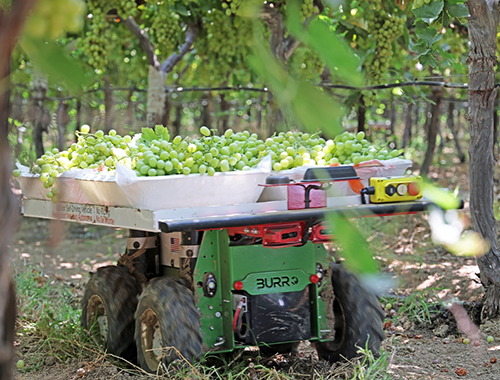
Whereas follow robots generally rely upon following a tag in a person’s pocket, Burro, because of deep learning and computer vision , sees the world and navigates through it using cameras and sensors.
Another class of AMRs are the “tough boy” robots. You know the ones; they sound like this.
With global warming bringing dramatic increases in wild weather, wild fires, and wild disasters, “tough boy” robotics are more and more coming into vogue to fight the global-warming battle or to prevent people from getting into harm’s way. Or at construction sites; or in mining, either above or below ground. Some have tank treads; some others have big-boy wheels.
Two of the best hail from the great State of Maine. Howe and Howe Technologies, now owned by Textron, and c-Link Systems, continuously owned and operated since 1997 by Bill Lovell. Each is about 50 miles from one another.
Howe and Howe’s machines can be seen in Hollywood movies, and like the Thermite robot, fighting fires in Los Angeles and elsewhere. Due north, in Norway, ME, c-Link Systems builds tough boys like the Forager Sandbagging System, which is always handy for impending disasters. Lately, c-Link has taken to narrow-vein mining with a small fleet of “tough boy” robots.
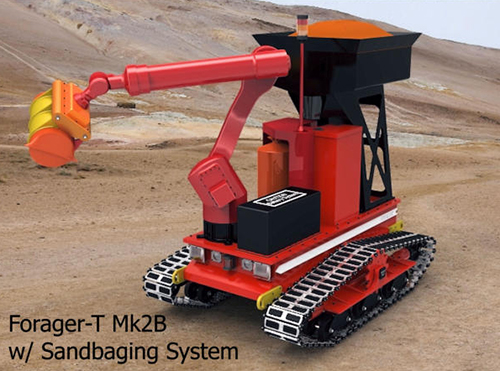
From warehouses to farming to narrow-vein mining, it looks very much like we are entering into the Golden Age of AMRs. An age that may last for a very long time or at least as long as mobility and intelligence are needed in logistics, agriculture, construction or mining.
Which, of course, means just about forever.
Is This the Golden Age of AMRs?
PDF download

